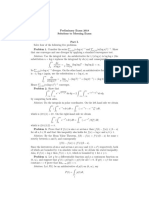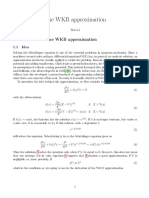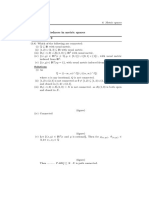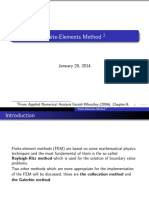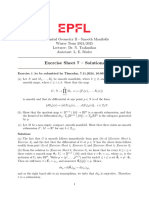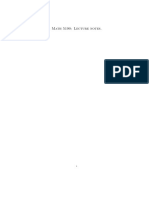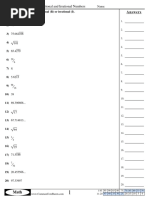Ps 8 Sol
Ps 8 Sol
Uploaded by
Angelo OppioCopyright:
Available Formats
Ps 8 Sol
Ps 8 Sol
Uploaded by
Angelo OppioOriginal Title
Copyright
Available Formats
Share this document
Did you find this document useful?
Is this content inappropriate?
Copyright:
Available Formats
Ps 8 Sol
Ps 8 Sol
Uploaded by
Angelo OppioCopyright:
Available Formats
d-math Analysis II: Several Variables ETH Zürich
Federico Franceschini Problem set 8 FS 2024
Problems marked with a (*) are a bit more complex and can be skipped at a first read.
If you don’t have a lot of time focus on the Problems/subquestions marked with (♡).
8.1. BONUS PROBLEM. Let X ⊂ R be a Jordan-null set (as in Definition 13.8).
(a) Show rigorously that X × X ⊂ R2 is also Jordan-null.
(b) Show rigorously that X × [0, 1] ⊂ R2 is also Jordan-null.
8.2. True or False. (♡)
1. A bounded countable set is always Jordan-null.
2. A countable set is always Lebesgue-null.
3. Let D ⊂ [0, 1] be a dense set (i.e., D = [0, 1]). Then µout (D) = 1. (µout was defined
in Definition 13.7).
4. Let X, Y ⊂ [0, 1] Jordan measurable sets such that µ(X) > 1/2 and µ(Y ) > 1/2.
Then X ∩ Y ̸= ∅.
5. Let X, Y ⊂ [0, 1] such that µout (X) > 1/2 and µout (Y ) > 1/2. Then X ∩ Y ̸= ∅.
8.3. Fat Boundary. Construct an open subset U ⊂ R for which the boundary ∂U is
not a null set.
8.4. Multiple Choice. (♡) Let U ⊂ Rn be a nonempty, open subset, f : U → Rm a
function, and N ⊂ U a Jordan null set. In which of the following cases is the image
f (N ) ⊂ Rm necessarily a null set? Attention: Only one answer is correct!
1. If f is uniformly continuous.
2. If f is uniformly continuous and m ≥ n.
3. If f is locally Lipschitz continuous.
4. If f is locally Lipschitz continuous and m ≥ n.
8.5. Change of variables and Jacobians. (♡) For each of the following domains and
change of variables find the jacobian and the appropriate transformed domain. There is
no need to actually compute the integrals!
1. A := {(x1 , x2 ) ∈ R2 : x1 > 0, x2 < x1 , 1 < x21 + x22 < 4} and x1 = r cos θ, x2 = r sin θ.
Using the change of variables formula, complete the dots in the following formula
ˆ ˆ
2
x1 sin(x2 ) dx1 dx2 = ... drdθ
A ...
assignment: April 15, 2023 due: Apr 22, 2023 1/8
d-math Analysis II: Several Variables ETH Zürich
Federico Franceschini Problem set 8 FS 2024
2. B := {(x, y) ∈ R2 | 1 < xy < 2, x2 < y < 2x2 } and u := xy, v := x2 . Using the
change of variables formula, complete the dots in the following formula
ˆ ˆ
2 −xy
y e dxdy = ... dudv
B ...
3. C := {(x, y, z) ∈ R3 | 1 < z − 2y < 2, 0 < z < 1, −2 < 3x + y + z < 0} and
u := z, v := z − 2y, w := 3x + y + z. Using the change of variables formula, complete
the dots in the following formula
ˆ ˆ
xyz dxdy = ... dudvdw.
C ...
8.6. The Cantor set. (*) Let X ⊂ [0, 1] be the set of all real numbers whose decimal
expansion does not contain the digit 8.1 Show that:
1. X is a Lebesgue null set,
2. X is uncountable,
3. X × X ⊂ [0, 1]2 is a Lebesgue null set.
4. Show that X is compact (it is important the choice made in the footnote!).
1
The decimal expansion is not always unique. For example, 0.8 = 0.79999 . . .. Whenever x has at least
one decimal expansion not containing 8, we rule that x belongs to X, so for example 0.32579 ∈ X,
0.32589 ∈ X
assignment: April 15, 2023 due: Apr 22, 2023 2/8
d-math Analysis II: Several Variables ETH Zürich
Federico Franceschini Problem set 8 FS 2024
Hints:
8.2.5 µout can be positive and large on very sparse sets...
8.3 Any open subset of R is an union of disjoint open intervals. Try to achieve that U
has a very small “total volume”, but still contains all rational numbers in [0, 1].
assignment: April 15, 2023 due: Apr 22, 2023 3/8
d-math Analysis II: Several Variables ETH Zürich
Federico Franceschini Problem set 8 FS 2024
8. Solutions
Solution of 8.1: For ϵ > 0 there is a finite collection of dyadic intervals {I1 , . . . , IN }
such that X
X ⊂ I1 ∪ . . . ∪ IN , µ1 (Ii ) ≤ ϵ.
1≤1≤N
Now we must have
X × [0, 1] ⊂ I1 × [0, 1] ∪ . . . ∪ IN × [0, 1],
and so X X
µout (X × [0, 1]) ≤ µ2 (Ii × [0, 1]) = µ1 (Ii ) ≤ ϵ.
1≤i≤N 1≤1≤N
Since ϵ was arbitrary, µout (X × [0, 1]) = 0. Since without loss of generality we may have
assumed that X ⊂ [0, 1] then
µout (X × X) ≤ µout (X × [0, 1]) = 0.
Solution of 8.2:
1. False, Q is acounterexample.
2. True, number it’s elements {ak }k∈N and cover it with {ak + ϵ2−k [−1, 1]}k∈N .
3. True, pick any finite dyadic partition of [0, 1]. Then each interval must contain at
least one element of D by density. Hence if we want to cover D we must keep all
these intervals, whose length sums to 1.
4. True. By contradiction, assume that X ∩ Y = ∅. By Theorem 13.18, we must have
µ(X ∪ Y ) = µ(X) + µ(Y ) > 1. On the other hand, since X ∪ Y ⊆ [0, 1], it holds
µ(X ∪ Y ) ≤ µ([0, 1]) = 1, which gives the desired contradiction.
√
5. False, take X = Q ∩ [0, 1] and Y := ( 2 + Q) ∩ [0, 1].
Solution of 8.3: Let 0 < ϵ < 1/2 and (qn )n∈N be a enumeration of [0, 1] ∩ Q. We define
In := (qn − ϵ2−n , qn + ϵ2−n ) and
[
U := In .
n∈N
By construction, we then have [0, 1] ∩ Q ⊂ U and the “total volume”2 is small, in the
sense that
∞ ∞
2−n = 2ϵ.
X X
vol(In ) = 2ϵ (1)
n=1 n=1
We now show that this set U satisfies the requirements in the problem statement. Being a
union of open intervals, U is certainly open in R. Next, we notice that due to [0, 1]∩Q ⊂ U ,
2
We always write this in quotation marks because the point of this exercise is that this set U is not
Jordan-measurable.
assignment: April 15, 2023 due: Apr 22, 2023 4/8
d-math Analysis II: Several Variables ETH Zürich
Federico Franceschini Problem set 8 FS 2024
the entire interval [0, 1] is contained in the closure U of U . Using the boundary of U , this
can be written as
∂U ∪ U = (U \ U ) ∪ U = U ⊃ [0, 1].
In view of (1), it is therefore natural to conjecture that for a covering of ∂U by open
boxes (Ql )l in R (that is, by intervals), it is necessary that
∞
X
vol(Ql ) ≥ 1 − 2ϵ (2)
l=1
must hold. To prove this lower bound, we first notice that for such a covering of the
boundary
[ [
[0, 1] ⊂ ∂U ∪ U ⊂ In ∪ Ql
n∈N l∈N
is an open covering of the compact interval [0, 1]. Therefore, finitely many of these sets
suffice to cover it; thus, there exist N, L ∈ N such that
N
[ L
[
[0, 1] ⊂ In ∪ Ql .
n=1 l=1
Both the In and the Ql are open intervals, whose volume is computed as the difference
of the right and left endpoints. Elementary considerations3 show that therefore for the
volumes, it holds that
N
X L
X
1≤ vol(In ) + vol(Ql ).
n=1 l=1
From this, using (1), we now obtain
∞
X L
X N
X ∞
X
vol(Ql ) ≥ vol(Ql ) ≥ 1 − vol(In ) ≥ 1 − vol(In ) = 1 − 2ϵ,
l=1 l=1 n=1 n=1
exactly as in (2). Since ϵ was chosen such that 1 − 2ϵ > 0, this shows that ∂U cannot be
a null set.
Solution of 8.4: The only correct one is number 4 which is Lemma 13.6.
Solution of 8.5:
3
If an interval [a, b] is covered by finitely many intervals J1 , . . . , Jr , ordered increasingly by their left
Pk
endpoints, then the right endpoint of Jk is at most a + j=1 vol(Jj ). Therefore, for the right endpoint
Pr
b to also lie in one of the intervals Jj , it must hold that j=1 vol(Jj ) ≥ b − a.
assignment: April 15, 2023 due: Apr 22, 2023 5/8
d-math Analysis II: Several Variables ETH Zürich
Federico Franceschini Problem set 8 FS 2024
1. If x1 = r cos θ, x2 = r sin θ then we have
(x1 , x2 ) ∈ A ⇐⇒ (r, θ) ∈ {−π < θ < π, sin θ < cos θ, 1 < r < 2}
solving the inequality
−π < θ < π, sin θ < cos θ ⇐⇒ −π < θ < π/4.
So, recalling that the jacobian is r, we find
ˆ ˆ 2 n ˆ π/4 o
2
x1 sin(x2 ) dx1 dx2 = cos2 θ sin(r sin θ)dθ r3 dr.
A 1 −π
2. Notice that B ⊂ (0, ∞)2 so (x, y) are always positive and so are (u, v). We write
the inverse mappings
√ u
x = v, y = √ .
v
So we compute the determinant of
" 1 #
∂(x, y) 0 √
2 v
det = det √1
∂(u, v) v
∗
and so we find
du dv
dx dy = .
2v
The set B changes into
√ √
(x, y) ∈ B ⇐⇒ (u, v) ∈ {1 < u < 2, v v < u < 2v v},
⇐⇒ (u, v) ∈ {1 < u < 2, u2/3 < v < 2−2/3 u2/3 },
and the integrand y 2 e−xy changes into
u2 u
e
v
so summing up we find
ˆ ˆ 2 n ˆ 2−2/3 u2/3 o
2 −xy
y e dxdy = u 2
v −2 ev dv du.
B 1 u2/3
3. We compute the determinant
0 0 1
∂(u, v, w)
det = det 0 −2 1 = 6,
∂(x, y, z)
3 1 1
so dx dy dz = 61 du dv dw. And the set becomes
(x, y, z) ∈ C ⇐⇒ 0 < u < 1, 1 < v < 2, −2 < w < 0.
assignment: April 15, 2023 due: Apr 22, 2023 6/8
d-math Analysis II: Several Variables ETH Zürich
Federico Franceschini Problem set 8 FS 2024
To change variables in the function we need to compute the inverse mapping:
x = 31 w + 16 v − 12 u, y = 12 u − 21 v, z = u.
So we find
xyz = − 16 uvw + 16 u2 w + 13 u2 v − 1
12
uv 2 − 14 u3 .
So putting everything together
ˆ ˆ 1ˆ 2ˆ 0
1
xyz dx dy dz = v (−2uvw + 2u2 w + 4u2 v − uv 2 − 3u3 )du dv dw.
C 72 0 1 −2
Solution of 8.6:
1. Let An be the set that does not contain 8 up to the n-th decimal place. For example,
A1 = [0, 0.8] ∪ [0.9, 1].
The intervals that decompose A1 have total volume 0.9. The second set has form
A2 = [0, 0.08] ∪ [0.09, 0.18] ∪ · · · ∪ [0.69, 0.78] ∪ [0.79, 0.8] ∪ [0.9, 0.98] ∪ [0.99, 1].
The intervals that decompose A2 have total volume 9 · 0.09 = 0.81 (there are a total
of 11 intervals: 7 have length 0.09; and 4 intervals are shorter, but one finds 2 pairs
of 2 intervals each, which together also have length 0.09). We try to find a pattern
and consider A3 . Treating the 4 shorter intervals in A2 as if we had 2 intervals of
length 0.09, we see that each interval in A2 is divided into 9 intervals of length 0.009
(again by combining shorter intervals). Thus we have vol(A3 ) = 0.009 · 81 = 0.93 .
Analogously, we find that An consists of finitely many intervals whose total volume
vol(An ) = 0.9vol(An−1 )
which implies that vol(An ) = 0.9n .
To show that X is a Lebesgue null set, let ϵ > 0. Choose n ∈ N large enough such
that 0.9n < ϵ. Since An consists of finitely many intervals covering X and the sum
of the lengths of these intervals is 0.9n < ϵ, the claim follows. As a complement for
those who prefer explicit formulas: Let (Ink )sk=1
n
be the intervals defining An . Then
we have s s
n n
Ink and vol(In ) = 0.9n < ϵ.
[ X
X ⊂ An =
k=1 k=1
This shows that in fact X is also Jordan-null set.
2. If X were countable, we would write all numbers in a countably infinite list. As
in the Cantor diagonal argument, we take a number defined by the diagonal and
change each digit to a digit that is still not 8. This number is still in X, but does
not coincide with any number in our list. Contradiction! So X is uncountable.
assignment: April 15, 2023 due: Apr 22, 2023 7/8
d-math Analysis II: Several Variables ETH Zürich
Federico Franceschini Problem set 8 FS 2024
3. We can cover X ×X by the boxes in An ×[0, 1]. We have vol(An ×[0, 1]) = vol(An ) =
0.9n and the argument is analogous to part (a).
4. Each of the {Ai } of step 1 is compact, being the union of finitely many closed
disjoint intervals in [0, 1]. Our set by definition is
[
X := Ai ,
i≥1
which is closed (being an intersection of closed sets) and bounded (since A1 is
bounded). Hence X is compact.
assignment: April 15, 2023 due: Apr 22, 2023 8/8
You might also like
- Introduction To Real Analysis by Christopher HeilDocument416 pagesIntroduction To Real Analysis by Christopher HeilDipendranath Mahato100% (4)
- Examen 2022Document3 pagesExamen 2022camillou.beckNo ratings yet
- (FREE PDF Sample) Optimization Models Instructor S Solution Manual Solutions 1st Edition Giuseppe C. Calafiore EbooksDocument84 pages(FREE PDF Sample) Optimization Models Instructor S Solution Manual Solutions 1st Edition Giuseppe C. Calafiore Ebookshotboxjuansa100% (6)
- Exercise 11 - SolutionsDocument13 pagesExercise 11 - Solutionslojoj3No ratings yet
- Prehistory SobolevDocument36 pagesPrehistory SobolevJoão MotaNo ratings yet
- Suggested Solution To Assignment 1 - MATH4220 PDFDocument10 pagesSuggested Solution To Assignment 1 - MATH4220 PDFjhonmt7No ratings yet
- Math4220 PDFDocument10 pagesMath4220 PDFjhonmt7No ratings yet
- Suggested Solution To Assignment 1 - MATH4220Document10 pagesSuggested Solution To Assignment 1 - MATH4220Ben WiswellNo ratings yet
- 1 Review of Key Concepts From Previous Lectures: Lecture Notes - Amber Habib - December 1Document4 pages1 Review of Key Concepts From Previous Lectures: Lecture Notes - Amber Habib - December 1Christopher BellNo ratings yet
- Xy 2 Xyz XTT 2x+3tDocument2 pagesXy 2 Xyz XTT 2x+3tSketchily SebenteNo ratings yet
- Compre (2017)Document2 pagesCompre (2017)f20221235No ratings yet
- Instant download Optimization Models Instructor s Solution Manual Solutions 1st Edition Giuseppe C. Calafiore pdf all chapterDocument81 pagesInstant download Optimization Models Instructor s Solution Manual Solutions 1st Edition Giuseppe C. Calafiore pdf all chapterfayyoodefeu100% (1)
- Taller6 EDPDocument8 pagesTaller6 EDPdiego.gomezr1No ratings yet
- MidtermDocument1 pageMidterm3dd2ef652ed6f7No ratings yet
- 15math eDocument7 pages15math eJuan PerezNo ratings yet
- Problems and Solutions For Partial Differential EquationsDocument74 pagesProblems and Solutions For Partial Differential EquationsAntonio SaputraNo ratings yet
- MAT351Y, 2024-2025 Homework 1, Due Tue Sept 17, 2024: U U U U U U UDocument1 pageMAT351Y, 2024-2025 Homework 1, Due Tue Sept 17, 2024: U U U U U U UMethylNo ratings yet
- EMT 4701 Applied Maths FinalDocument15 pagesEMT 4701 Applied Maths FinaltonnixxamNo ratings yet
- F15 SolutionsDocument7 pagesF15 Solutionsshraban dasNo ratings yet
- Assignment 1 Due Date: Feb 13, 2015Document1 pageAssignment 1 Due Date: Feb 13, 2015Amrita FrancisNo ratings yet
- WBMT2049-T2/WI2032TH - Numerical Analysis For ODE'sDocument23 pagesWBMT2049-T2/WI2032TH - Numerical Analysis For ODE'sJoost SchinkelshoekNo ratings yet
- Math 220 Final ExamDocument3 pagesMath 220 Final ExamElle Michelle YangNo ratings yet
- Ana 2018Document2 pagesAna 2018Atoloye Habeeb OlawaleNo ratings yet
- MSRI Sheet 1Document4 pagesMSRI Sheet 1ct uNo ratings yet
- Direct Method SlidesDocument44 pagesDirect Method SlideszazarNo ratings yet
- Linearalgebra5 10-2Document12 pagesLinearalgebra5 10-2lakshmimohanreddy33No ratings yet
- 423 Pset6-2ai3omxDocument2 pages423 Pset6-2ai3omxHuai Kai LinNo ratings yet
- Homework 7Document3 pagesHomework 7Luis EduardoNo ratings yet
- 175 MainDocument60 pages175 Mainmyturtle game01No ratings yet
- Homework 1 Graduate Real AnalysisDocument4 pagesHomework 1 Graduate Real AnalysislordpersonNo ratings yet
- Div Grad CurlDocument7 pagesDiv Grad CurlFafa SMADANo ratings yet
- Anasol 2018Document6 pagesAnasol 2018Atoloye Habeeb OlawaleNo ratings yet
- Segmentacin de Venas: 1 Fixed-Period Problems: The Sublinear CaseDocument6 pagesSegmentacin de Venas: 1 Fixed-Period Problems: The Sublinear CaseFer AgrazNo ratings yet
- ProblemSet2024 Week3 SolutionsDocument12 pagesProblemSet2024 Week3 Solutionssiem.peeleNo ratings yet
- Lecture2 ODEDocument16 pagesLecture2 ODEhoungjunhong03No ratings yet
- qms17 7sDocument9 pagesqms17 7sMarisol Hernández SánchezNo ratings yet
- Homework 2, Due Wednesday, February 7th Computational ProblemsDocument2 pagesHomework 2, Due Wednesday, February 7th Computational ProblemshenrychenaceNo ratings yet
- 8.2. Connectedness in Metric Spaces Problem Set 9Document9 pages8.2. Connectedness in Metric Spaces Problem Set 9Yogesh RanaNo ratings yet
- Week 2 SolDocument4 pagesWeek 2 Solesteban sedanoNo ratings yet
- Parte 6Document7 pagesParte 6Elohim Ortiz CaballeroNo ratings yet
- Two Jumping Nonlinear Terms and A Nonlinear Wave Equation: Tacksun Jung and Q-Heung ChoiDocument13 pagesTwo Jumping Nonlinear Terms and A Nonlinear Wave Equation: Tacksun Jung and Q-Heung ChoiAbdoulrazack Mohamed AbdiNo ratings yet
- MA261Notes Part1Document33 pagesMA261Notes Part1lasnieyanNo ratings yet
- Tema 5Document14 pagesTema 5guillermo araus pérezNo ratings yet
- Urysohn MetrizationDocument7 pagesUrysohn Metrizationvictorjuma745No ratings yet
- 173 HW1Document2 pages173 HW1Tor MethasateNo ratings yet
- Am 53Document11 pagesAm 53Mikael Yuan EstuariwinarnoNo ratings yet
- MTH600 (A) ConvexDocument11 pagesMTH600 (A) ConvexFatima AliNo ratings yet
- 2021 SubjectiveDocument9 pages2021 Subjectivealpha0rnksrkrNo ratings yet
- SolucoesDocument16 pagesSolucoescayo fagundesNo ratings yet
- Notes On Partial Differential Equations (Theory)Document129 pagesNotes On Partial Differential Equations (Theory)Elhibari OthmaneNo ratings yet
- Ward NotesDocument101 pagesWard NotesCesare AngeliNo ratings yet
- Math 3215 Intro. Probability & Statistics Summer '14 Group Quiz 6Document3 pagesMath 3215 Intro. Probability & Statistics Summer '14 Group Quiz 6Pei JingNo ratings yet
- Dif Form-Kurt BryanDocument12 pagesDif Form-Kurt BryansayanNo ratings yet
- Exact and Approximate Expressions For The Period of Anharmonic OscillatorsDocument11 pagesExact and Approximate Expressions For The Period of Anharmonic OscillatorsjeremyNo ratings yet
- dg1 hw5 SolutionsDocument11 pagesdg1 hw5 Solutionschristophercabezas93No ratings yet
- EW Navier-Stokes EquationsDocument44 pagesEW Navier-Stokes EquationsrocketmenchNo ratings yet
- 2008 Final ExamDocument6 pages2008 Final ExamDean YuNo ratings yet
- Lesson 4 Separation of VariablesDocument11 pagesLesson 4 Separation of Variablesgabrielyaguel22No ratings yet
- Finite-Elements Method: January 29, 2014Document28 pagesFinite-Elements Method: January 29, 2014PriyaNo ratings yet
- Green's Function Estimates for Lattice Schrödinger Operators and ApplicationsFrom EverandGreen's Function Estimates for Lattice Schrödinger Operators and ApplicationsNo ratings yet
- 428_notes (1)Document29 pages428_notes (1)Angelo OppioNo ratings yet
- Exercise Sheet 7 - SolutionsDocument6 pagesExercise Sheet 7 - SolutionsAngelo OppioNo ratings yet
- MA715-note (1)Document127 pagesMA715-note (1)Angelo OppioNo ratings yet
- NotesAddendumDocument27 pagesNotesAddendumAngelo OppioNo ratings yet
- LectureNotes_PhDCourseUniPi_PolyaSzegoDocument20 pagesLectureNotes_PhDCourseUniPi_PolyaSzegoAngelo OppioNo ratings yet
- 465158_solutions9-24Document8 pages465158_solutions9-24Angelo OppioNo ratings yet
- Exercise Sheet 11 - SolutionsDocument10 pagesExercise Sheet 11 - SolutionsAngelo OppioNo ratings yet
- 465156_solutions8-24Document6 pages465156_solutions8-24Angelo OppioNo ratings yet
- Advanced Complex Analysis NotesDocument50 pagesAdvanced Complex Analysis NotesAngelo OppioNo ratings yet
- Notes Harmonic MeasureDocument202 pagesNotes Harmonic MeasureAngelo OppioNo ratings yet
- Part15Document16 pagesPart15Angelo OppioNo ratings yet
- Ag-Notes-All TopologyDocument95 pagesAg-Notes-All TopologyAngelo OppioNo ratings yet
- Measure Theory PrimerDocument33 pagesMeasure Theory PrimerAngelo OppioNo ratings yet
- Ergodic 2023 10 08Document31 pagesErgodic 2023 10 08Angelo OppioNo ratings yet
- Week 14Document20 pagesWeek 14Angelo OppioNo ratings yet
- Notes 4190Document73 pagesNotes 4190Angelo OppioNo ratings yet
- 457661lecture 6Document5 pages457661lecture 6Angelo OppioNo ratings yet
- Philippeter AxiomaticSetTheoryDocument54 pagesPhilippeter AxiomaticSetTheoryAngelo OppioNo ratings yet
- Week13 2Document11 pagesWeek13 2Angelo OppioNo ratings yet
- Topology RazDocument106 pagesTopology RazAngelo OppioNo ratings yet
- 18.952 Differential FormsDocument63 pages18.952 Differential FormsAngelo OppioNo ratings yet
- QM 1Document165 pagesQM 1Angelo OppioNo ratings yet
- Partial Differential Equations I: Part 1. PDE 1Document19 pagesPartial Differential Equations I: Part 1. PDE 1Angelo OppioNo ratings yet
- Analysis IIIDocument278 pagesAnalysis IIIAngelo OppioNo ratings yet
- Identifying Rational and Irrational Numbers: I R R I R R I R R R I I I R R R R R I RDocument20 pagesIdentifying Rational and Irrational Numbers: I R R I R R I R R R I I I R R R R R I RRygiem Dela Cruz100% (1)
- Singleton C#Document8 pagesSingleton C#Trọng Hiếu TrầnNo ratings yet
- Periyar University-dde-BSc-physics - Syllabus PDFDocument23 pagesPeriyar University-dde-BSc-physics - Syllabus PDFபிரபாகரன் பிரபாகரன்No ratings yet
- Aits 2021 CRT II Jeea Paper 1 SolDocument9 pagesAits 2021 CRT II Jeea Paper 1 SolAnoushka DeyNo ratings yet
- Lean Six Sigma NotesDocument9 pagesLean Six Sigma NotesMahmoud MohamedNo ratings yet
- Classification and PredictionDocument41 pagesClassification and Predictionkolluriniteesh111No ratings yet
- Error Correction Code Megafunctions User Guide: (Altecc - Encoder and Altecc - Decoder)Document46 pagesError Correction Code Megafunctions User Guide: (Altecc - Encoder and Altecc - Decoder)Maileth Rivero PalacioNo ratings yet
- Elzaki Transform Homotopy Perturbation Method For Solving Porous Medium EquationDocument4 pagesElzaki Transform Homotopy Perturbation Method For Solving Porous Medium EquationesatjournalsNo ratings yet
- PlantPAx HMI Security ConfigurationDocument1 pagePlantPAx HMI Security Configurationcchung147554No ratings yet
- FFL Flower Addition PDFDocument10 pagesFFL Flower Addition PDFmarianapintrijel0% (1)
- UPCAT Mathematics Practice Questions Set 1Document10 pagesUPCAT Mathematics Practice Questions Set 1Irishmae HervasNo ratings yet
- Turning PDFDocument140 pagesTurning PDFDulis Dulis100% (1)
- Ratio and Proportion: Concept of RatiosDocument32 pagesRatio and Proportion: Concept of RatiosPatel HeminNo ratings yet
- LS3 Math-DLP-JHS (Draw Number Line)Document7 pagesLS3 Math-DLP-JHS (Draw Number Line)Leslie Ann RojoNo ratings yet
- Arithmetic, Geometric and Quadratics Sequence PracticeDocument1 pageArithmetic, Geometric and Quadratics Sequence Practicedevit siahaanNo ratings yet
- Week 1 PR 2Document30 pagesWeek 1 PR 2Ar Anne UgotNo ratings yet
- Assignment 1Document3 pagesAssignment 1Jingwei ZhongNo ratings yet
- Spotlight On MDSDocument43 pagesSpotlight On MDSFangting DuNo ratings yet
- Effect of Fault Resistance On Behavior of Distance ProtectionDocument6 pagesEffect of Fault Resistance On Behavior of Distance ProtectionShafqat HussnainNo ratings yet
- AS Physics Topic Wise Questions: ForcesDocument17 pagesAS Physics Topic Wise Questions: ForcesAryan KingerNo ratings yet
- Physics 170 - Mechanics: Circular MotionDocument24 pagesPhysics 170 - Mechanics: Circular MotionSteve IsaacsNo ratings yet
- (Original PDF) Statistics For Business: Decision Making and Analysis 3rd EditionDocument51 pages(Original PDF) Statistics For Business: Decision Making and Analysis 3rd EditionlebamtheskaNo ratings yet
- Finite Element Methods: Lecture Module 1-1: IntroductionDocument35 pagesFinite Element Methods: Lecture Module 1-1: IntroductionAhmad Faidhi100% (1)
- How To Remove Commas in Excel (9 Smart Ways) - ExcelDemy PDFDocument24 pagesHow To Remove Commas in Excel (9 Smart Ways) - ExcelDemy PDFtahirmaqpkNo ratings yet
- Econometrics FinalDocument6 pagesEconometrics Finalb54v95p594No ratings yet
- MAE 453 - 11 Lateral Dynamic StabilityDocument17 pagesMAE 453 - 11 Lateral Dynamic Stabilitymatthew_6100% (1)
- Ch04 Cost Volume Profit AnalysisDocument21 pagesCh04 Cost Volume Profit Analysiszoe regina castroNo ratings yet
- PDFDocument25 pagesPDFChoirul IkhsanNo ratings yet
- Lesson Plan Combination - Docx BalabaDocument4 pagesLesson Plan Combination - Docx Balabairene.buysonNo ratings yet































